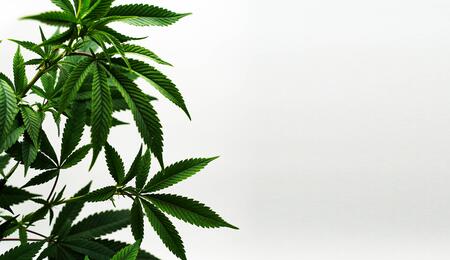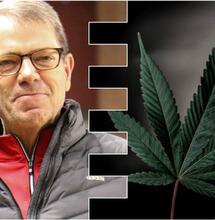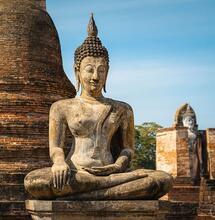Winter Gardening

When attempting to grow Cannabis a little thought should always be given to the weather conditions outside - even when you're growing indoors.
In this great and beautiful country we have many different climate zones, ranging from the tropical south-east to the frozen Alaskan tundra, and when attempting to grow Cannabis a little thought should always be given to the weather conditions outside - even when you're growing indoors. In winter, growing outdoors is all but impossible - save for in the southernmost areas where we can often achieve two harvests a year, and with some expert management have pot growing all year 'round. However, although indoor growing is of course possible at all times, one should still pay mind to the vagaries of climate, as micro-adjustments may be needed to maintain optimum growing conditions.
Many indoor growers in the temperate zones prefer the winter months, as the oft-experienced summer heat issues have miraculously disappeared; when using HPS lights it can often be easier to maintain that ideal 70-80° F temperature. However, when the dark period sets in, if outside temperatures are very low this can affect the plants inside the grow room. This is also an issue for users of cool lights such as LEDs and CFLs. Temperatures below 60° F can be crippling to your plants, if they are forced to endure them repeatedly or for sustained durations. Growth will slow to the point of being indiscernible, and if the temperature drops still further, the chance of the plant recovering reduces proportionately.
“Temperatures below 60° F can be crippling to your plants„
In such cold conditions, growers often attempt to provide extra heat in the form of heating pads or fan heaters; even covering cold floors with insulating materials or raising the plants a little above the ground can help, as the ground is usually the coldest point. Depending on the systems used, it can often take more energy to cool a room than to heat it, so warming your room in winter may cost a little less than cooling it in summer. Over all, the differences in cost and energy consumption are likely to be minimal - if you have to use extra systems to heat or cool, you're looking at spending more either way. Another factor that the indoor grower should consider in winter is humidity. Indoors, the relative humidity is often lower in winter than in summer, and can often be below the 40% considered to be the low point of the optimum range for Cannabis. This effect occurs due to the fact that most heating systems draw cold air in from outdoors, and heat it without adding any moisture. As cold air cannot hold as much water vapor as warmer air, the relative humidity drops.
If the air outside is 32° F, at 100% RH it will contain five grams of water. When heated to 77° F, that same air will be at only 23% RH, as at that temperature the saturation point is 22g/m³. To correct this, it may be necessary to install a cheap humidifier; plants experiencing the effects of low relative humidity transpire too much, requiring more frequent watering. Then, if nutrient levels are not corrected, this can lead to toxicity. Low RH may also slow growth by inhibiting full opening of the stomata, and symptoms similar to nutrient burn may appear in the leaves, as CO₂ and other compounds cannot escape (as with normal transpiration). However, low RH is not a huge concern; it can be cheaply and easily managed, and presents only slight danger to your plants.
“There are occasional reports from growers as far north as Ontario growing throughout winter in specially adapted greenhouses„
A very similar approach can be applied to greenhouse growing in winter. It is probable that extra lighting will be required in most latitudes, as the sunlight is weaker - much of the extra heat requirement can be supplied in this way. Covering the greenhouse with Mylar at night-time can help prevent heat loss and tell-tale traces of light (given that hours of daylight drop so low, in the more northerly climates artificially providing light after nightfall is the only way to sustain a crop through the dark months). Despite the inherent difficulties, there are occasional reports from growers as far north as Ontario growing throughout winter in specially adapted greenhouses.
Conversely, in California, many greenhouse growers keep plants in the vegetative stage throughout the winter, giving them the chance to grow large and bushy in preparation for spring. In such clement conditions, little extra heat and light is needed to maintain optimum conditions. The outdoor grower is the most unhappy in winter. In much of the US, winter conditions entirely preclude outdoor grows. In the southernmost states, there are some who will put hardy strains out through winter; however, while temperatures are mostly mild winter does bring extreme conditions, and storms are frequent and intense in many regions. Florida, despite its subtropical climate, has sustained periods of below-60° F temperatures, and humidity can drop sharply. But, if a sheltered spot is carefully selected, crops can survive the winter - although the yield will be reduced. Even in the tropical southern corner of Florida, where temperatures never drop below 60° F, the drop in light levels means the yield is less than optimum.
However, in this tropical corner of the continental United States, it's possible for a short growing season to run from December to March - much as in Thailand, Hawaii and India. The tropical sativas from these regions are adapted to grow almost year-'round, and their flowering period is often triggered by age rather than photoperiod. In southern- and coastal California, the prevailing Pacific winds keep the weather mild through the winter as warm ocean air currents pass eastward, meaning that frost is very rare. Some varieties of long-flowering Cannabis will continue to produce THC right up until the winter solstice on the 21st of December, after which THC production ceases. Throughout the southern states, the shorter days and weaker sunlight cause plants to grow less vigorously and yield smaller harvests than in summer, but in many places it is possible to complete a grow cycle - a little research and experimentation with your set-up is all that's required.



